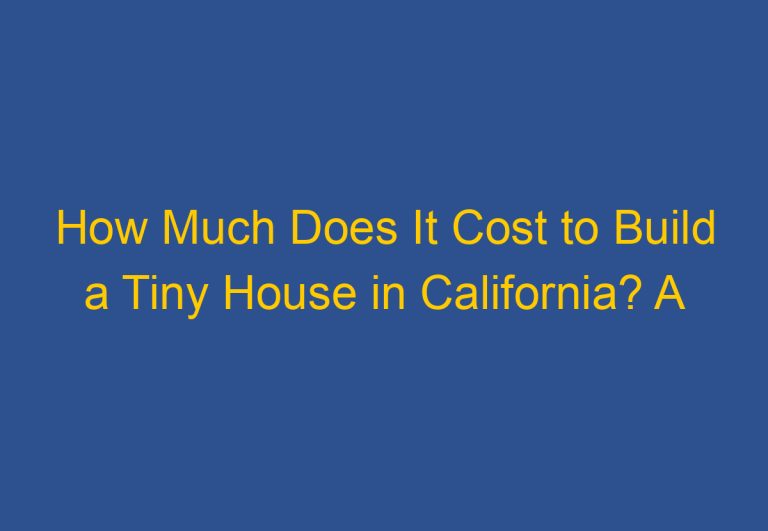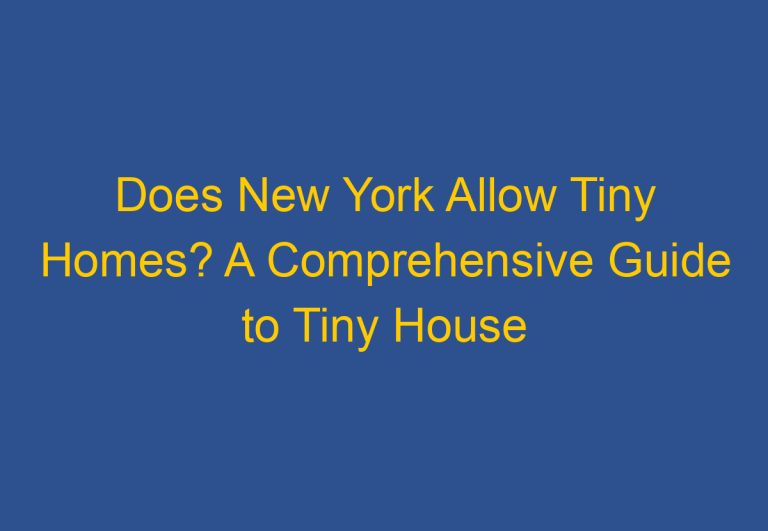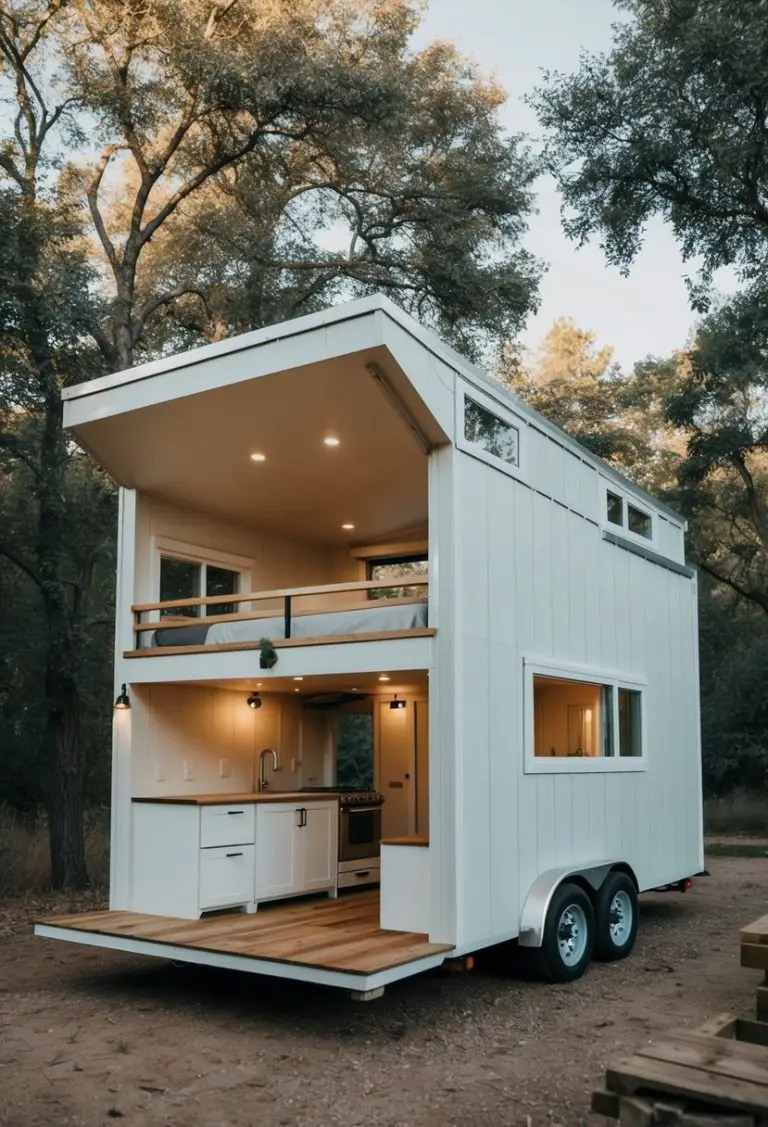Does New York Allow Tiny Houses? A Comprehensive Guide to Tiny House Regulations in New York State
Tiny houses have become increasingly popular in recent years as people look for more affordable and sustainable housing options. However, the legality of these small dwellings can vary greatly depending on the location. In the case of New York, the answer to the question of whether or not tiny houses are allowed is not a straightforward one.
While there are no statewide laws specifically regulating tiny houses in New York, local zoning regulations play a significant role in determining their legality. Some cities and counties in the state allow tiny houses as accessory dwelling units (ADUs), while others have strict size limits on homes. Additionally, the regulations and standards may differ depending on the region and type of tiny house.
It’s important to note that many counties in New York allow permanent dwellings in ADUs, which are supplementary dwelling units on residential properties. However, tiny houses must meet certain size requirements, with a minimum square footage of 200 square feet and a maximum of 1500 square feet. The ceiling height requirements also vary for different areas within the ADU.
Legality of Tiny Houses in New York
Tiny houses have become a popular alternative to traditional homes, but their legality varies from state to state. In New York, the legality of tiny houses depends on several factors, including zoning laws and building codes.
Zoning and Building Codes
Zoning regulations vary across different cities, towns, and villages in New York. Therefore, reviewing local zoning and land use regulations is essential to determine the legality of building and living in a tiny house in your location. The state has adopted Appendix Q, which provides building guidelines for tiny houses. The 2020 Residential Code of New York State includes the adoption of Appendix Q titled “Tiny Houses.” Appendix Q, applicable to tiny houses used as single dwelling units, defines a tiny house as “a dwelling that is 400 square feet (37 m2) or less in floor area excluding lofts.”
Tiny Houses on Wheels (THOWs) and Accessory Dwelling Units (ADUs)
Tiny homes, also known as ADUs (Accessory Dwelling Units), are legally allowed in some places in New York State. They must meet some tiny house size requirements, with a minimum square footage of 200 square feet and a maximum of 1500 square feet. The ceiling height requirements are for different areas within the ADU. However, the legality of Tiny Houses on Wheels (THOWs) is still in question in New York, as they are not explicitly mentioned in the state’s building code requirements.
In conclusion, the legality of tiny houses in New York is a complex issue that depends on several factors. While the state has adopted Appendix Q, which provides building guidelines for tiny houses, zoning regulations vary across different cities, towns, and villages in New York. Therefore, reviewing local zoning and land use regulations is essential to determine the legality of building and living in a tiny house in your location.
Living in a Tiny House in New York
Living in a tiny house in New York can be an affordable and sustainable housing option for those who want to live a minimalist life. However, there are rules and regulations that must be followed to ensure safety and compliance with building standards.
Safety and Building Standards
When building a tiny house, it is important to obtain the necessary permits and follow the safety construction codes set by the municipality. In New York, the 2020 Residential Code of New York State includes the adoption of Appendix Q titled “Tiny Houses,” which provides building guidelines for tiny houses.
Tiny homes must meet certain size requirements, with a minimum square footage of 200 square feet and a maximum of 1500 square feet. The ceiling height requirements are different for various areas within the ADU. Additionally, all homes must be at least 400 square feet to be considered habitable.
Structural integrity is crucial when building a tiny house. The floor space and ceiling height must be sufficient to provide emergency escape routes in case of a fire or other emergency.
Community and Lifestyle
Tiny house communities have become increasingly popular in New York, offering a sense of community and a sustainable lifestyle. These communities provide an opportunity for like-minded individuals to live in a small space and share resources.
One can choose to live in a tiny house in an RV park or a park model community. However, it is important to check with local authorities and perform extensive research to get a good idea of their particular rules and requirements.
Living in a tiny house can also be an affordable housing option for those looking to downsize or live in a smaller space. It can be environmentally friendly and promote a sustainable lifestyle.
In conclusion, living in a tiny house in New York can be a viable option for those who want to live a minimalist life. However, it is important to follow safety and building standards, obtain necessary permits, and research local rules and regulations. Tiny house communities can offer a sense of community and a sustainable lifestyle.
Frequently Asked Questions
What are the zoning regulations for tiny houses in New York state?
Zoning regulations for tiny houses in New York state can vary depending on the region and type of tiny house. Many counties in New York allow permanent dwellings in accessory dwelling units (ADUs), which are supplementary dwelling units on residential properties. However, it is important to note that building codes and zoning regulations for ADUs can be strict and must be followed closely.
Can I legally build a tiny house on my property in New York?
Yes, it is possible to legally build a tiny house on your property in New York, but it is important to follow the state’s building codes and zoning regulations. Additionally, if the tiny house is intended to be a permanent dwelling, it must meet the requirements for an accessory dwelling unit (ADU).
Where are tiny house communities located within New York?
Tiny house communities are located throughout New York state, but they are not as common as in other states. Some of the most popular tiny house communities in New York include Hudson River Tiny Homes in Catskill, Escape Brooklyn in the Hudson Valley, and Tumbleweed Tiny House Company in the Finger Lakes region.
What is the minimum square footage for a dwelling in New York state?
In New York state, there is no minimum square footage requirement for a dwelling. However, if the tiny house is intended to be a permanent dwelling, it must meet the requirements for an accessory dwelling unit (ADU), which typically range from 200 to 1500 square feet.
How do accessory dwelling units (ADUs) fit into New York housing laws?
Accessory dwelling units (ADUs) are extra homes on the same property as the main house. In New York, tiny homes built on foundations are considered ADUs. Making an ADU is trickier than a tiny house on wheels because you have to follow local building and zoning rules, especially when working with a tiny house builder in New York.
What are the average costs associated with purchasing a tiny house in New York?
The average cost of purchasing a tiny house in New York can vary depending on the size, features, and location. On average, a tiny house in New York can cost anywhere from $30,000 to $150,000. It is important to do your research and compare prices before making a purchase.










